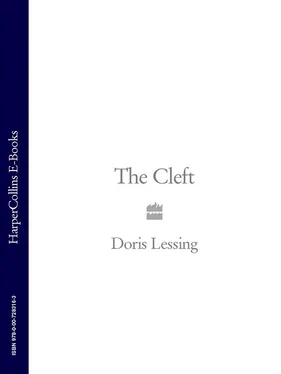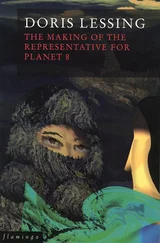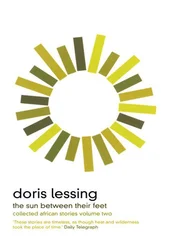It was not likely that these people who seemed to live in a dream were regular in their sacrificing, or regular in anything; impulses and rhythms we may hardly guess at governed their lives. But while there was no way of counting the skeletons or making an estimate of what the dust layers meant in terms of time, we may confidently say that we are talking of long periods of time – ages.
Of changelessness, of an existence like those fish that wash back and forth on the tides, responding to the moon’s changes. And then the real change, the defining change, the birth of the deformed ones, the Squirts, the Monsters. The beginning of squirming emotional discomfort, unrest, discontent: the start of awareness of themselves, their lives. The start only, like the affront the stranded fish must feel at the probing stick.
There is a part of this tale that has to remain dark. Yes, yes, previous attempts at solving the mystery have offered solutions more like myths than probabilities. How did the community of males begin? We cannot believe that the eagles fed the infants regurgitated raw meat and kept them warm in their feathers. No, there is a solution and this is it.
The defective infants put out on the Killing Rock were for – how long? – food for the eagles. And the very first Monsters must have been too. But then – but when we don’t know – boys kept as ‘pets’ and playthings by the Clefts escaped. We know that small boys as young as four, certainly aged five, six, seven, can achieve feats of endurance and even of strength. Two, three, four little boys ran away from the caves above the sea. The eagles, though they were very big, many times the size of the eagles we know, could not have carried children that size, not for fair distances. The children saw where the eagles flew back, to their nests, past the Killing Rock, over the valley, up the mountain – and they followed. Up on the ridge, where the eagles’ nests were, they did not linger. How terrifying those enormous birds must have been. Down the other side and into the valley where the great river was. The children had been reared on fish, and here were fish again, though different ones. They had been kept warm in the caves. But they were still little children, and how very large the valley they found themselves in must have seemed. How can we not admire them for their daring and their cleverness? The river was wide, deep, and rushed along. Yet they had to catch fish in it. How did they shelter? It did not at once become possible to make huts and sheds: they had never seen anything like them. They had seen the eagles’ nests and they dragged sticks and then larger sticks and made piles of them, and crept into them when dark came. Then they grew bigger and stronger and they began leaning fallen branches together to make shelters. This was an easy climate; they did not have to fear cold. But let us not forget the beasts in the forests that stood at a distance on either side of the great river. How they escaped the beasts has to remain a bit of a marvel. Did some god or goddess aid the little things? But in their records is never the mention of divine intervention. Yes, they were the children of the Eagle, but that is as far as divinity went, for them.
We must remember the first little males were badly mutilated, in ways I for one would rather not dwell on. Their ‘squirts’ had been so mishandled, pulled and played with, and their sacs had sometimes been cut off for the game of extracting the stones, and above all, they had never known tenderness or maternal care. Their mothers had fed them, on the orders of the Old Shes, but reluctantly, and never enough. We may like to soften this painful story by imagining a Cleft who did feel some affection for her misbegotten babe, but she would have had to hide what she felt, and any caresses or care must have been sketchy. And they were tough, and hardy and skilful at avoiding attention. Skinny little boys, but strong and fearless, improbably surviving, but at least they were away from their tormentors, the Clefts.
Then something remarkable happened. The eagles brought them some boy babies, left out on the Killing Rock. Hungry yelling babies, but not mutilated; and how were the little boys to feed them?
Not only dangerous wild animals lived in the forests, friendly ones did too. The little boys saw deer, with fawns and probably had their first lessons in parental love, watching does with their fawns. They crept close, to watch. A doe stood its ground, unafraid: there was no reason yet for any animal to fear our kind. And besides, this was a child, and needy. The boy stood fondling the doe’s soft fur, while the fawn butted or licked his legs. Then the fawn began to suckle. And the boy, kneeling, did the same. The doe stood, and turned her head and licked the child. And so that was how began the intimacy between the children and the deer.
There was a song, ‘We are the children of the deer’, but it was never as compelling as the songs about the eagles.
When the new babies howled and screamed and the little boys knew they had to be fed, what could have been more natural than for the babes to be taken to the does, who had soon to learn to lie down, the babes beside them. And what did the does gain from this? We may speculate. It is my belief that animals are more intelligent than we ever give them credit for. After all, it was a she wolf who suckled our forefathers, Romulus and Remus. Her statue and the two babes are much loved by us. Probably the beginning of this bond was the terrible need of the babes, who were dying for lack of what the deer – and the she wolf – had in plenty. Need calls forth its response.
And why did the eagles take to saving the babes and bringing them over the mountain to the lads, instead of devouring them? For one thing, the boys caught fish for the eagles, and laid them on the grass, and the great birds, having delivered their burden of screaming babies, would stand over the fish, enormous fish, and feed there, and often they came between deliveries of babes, for their meals. Or they would take a fish or part of one – there were very large fish in the river – up into the mountain for their nestlings.
And the second wave of Monsters, or Squirts, were not mother-deprived, but were licked and nuzzled and fed by the kindly deer, who sometimes played with the fawns as if they were fawns themselves.
The feeding babies and deer would have to lie down together. There were no vessels or containers then. Soon, though, shells from the river became utensils, and gourds. There was not nearly as much weed in the river as there was in the sea, but these boys grew into strong lads, and the seashore was not far for hardy boys. This shore was a distance from the Clefts’ shore, but continuous with it. The boys did not know for a long time that if they had journeyed in one direction along their beaches – they had beaches, the Clefts only had smooth warm rocks – they would encounter the Clefts, their persecutors.
They brought varieties of weed from the sea, and shellfish, and some sea fish, and the new babes were fed very well, as soon as they outgrew milk. And the friendly deer were offered weed, which they liked, and flesh of the fish and shellfish, but this they did not like.
But it must have been hard for the boys, keeping the babes fed, even with the aid of the deer. The eagles were always bringing more of the Monsters and these were not mutilated now. The eagles were perched on high rocks from where they could see the Clefts and their rocks, and as soon as there was a new little boy, they swooped and saved it and brought it over the mountain.
Some Squirts, we believe, were still hidden in the caves, but you cannot easily keep prisoner energetic boys, unless they are tied. Some Squirts were tied, but they made such a noise, yelling and screaming, that when they escaped, running away, guided by the great birds, the old Clefts were relieved. No more little boys were kept as ‘pets’, and the Clefts reverted to their earlier practice: any babe not snatched away by the eagles as they came out of the womb were put out on the Killing Rock and instantly carried off by the eagles.
Читать дальше












